Welcome to the definitive guide to Ride A Bike In Lombok, Indonesia’s hidden gem nestled east of Bali. This comprehensive guide will walk you through everything you need to know about exploring this tropical paradise on two wheels.
Unlike its more famous neighbor, Lombok offers cyclists an untouched experience with uncrowded routes, authentic cultural encounters, and pristine landscapes ranging from coastal paths to volcanic highlands.
As you pedal through this enchanting island, you’ll discover a perfect blend of challenging terrain, breathtaking vistas, and warm local hospitality.
Whether you’re an experienced cyclist seeking technical trails around Mount Rinjani or a casual rider looking to explore the southern beaches, Lombok provides an unforgettable cycling adventure for every skill level.
This guide covers everything from detailed route information and equipment recommendations to cultural insights and safety considerations, ensuring you’re well-prepared for your cycling journey in Lombok.
Planning Your Perfect Cycling Getaway
Best Time to Visit
The ideal time for cycling in Lombok spans from April to October. This dry season brings:
- Clear skies perfect for long rides
- Temperatures averaging 27-30°C (80-86°F)
- Lower humidity levels
- Well-maintained trails
“Lombok’s weather patterns create perfect cycling conditions during the dry season, but even in the wet season, morning rides can be magical.” – Mark Stevens, Local Cycling Guide
Understanding Lombok’s Climate and Seasons
The key to a successful cycling adventure in Lombok lies in understanding its tropical climate patterns:
Peak Season (April-October)
- Crystal clear skies with minimal rainfall
- Temperatures averaging 27-30°C (80-86°F)
- Humidity levels between 60-70%
- Excellent trail conditions across all regions
- Higher tourist numbers and accommodation rates
- Maximum availability of rental equipment
- Regular group rides and cycling events
- Optimal conditions for photography
Shoulder Season (March-April, October-November)
- Occasional afternoon showers
- Moderate temperatures with comfortable mornings
- Reduced tourist presence
- More competitive rental and accommodation rates
- Variable trail conditions requiring attention
- Lush greenery perfect for nature photography
- Balanced mix of sun and clouds
- Ideal for budget-conscious travelers
Wet Season (November-March)
- Early morning rides recommended before afternoon rains
- High humidity (80-90%) requiring extra hydration
- Some trails may become technically challenging
- Lowest tourist numbers and best accommodation deals
- Spectacular waterfalls and rushing rivers
- Rich tropical forest experiences
- Enhanced cultural immersion opportunities
- Perfect for experienced riders seeking adventure
Safety Tip: Always check local weather forecasts and natural risks before setting out, especially during transitional seasons.
Essential Routes for Every Skill Level
Beginner-Friendly Coastal Routes
Kuta to Tanjung Aan Beach Circuit
- Distance: 15km
- Elevation: Minimal
- Terrain: Mostly paved roads
- Highlights: Traditional villages, scenic landscapes
- Duration: 2-3 hours with stops
Intermediate Mountain Trails
Tetebatu Rice Terrace Loop
- Distance: 25km
- Elevation gain: 450m
- Terrain: Mixed (40% paved, 60% dirt trails)
- Key features: Rice terraces, rural areas, local culture
- Duration: 4-5 hours
Advanced Riders’ Challenge
Mount Rinjani Region Circuit
- Distance: 40km
- Elevation gain: 1,200m
- Terrain: Technical single tracks
- Features: Volcanic landscapes, trekking trails
- Duration: 6-8 hours
Local Transportation and Logistics
Bike Rental Options
| Rental Type | Daily Cost (USD) | Includes |
| Basic City Bike | $8-12 | Helmet, Lock |
| Mountain Bike | $15-25 | Full gear set |
| Premium E-Bike | $30-40 | All accessories |
Local SIM Card and Navigation
- Purchase at tourist hubs or airport
- Recommended providers: Telkomsel, XL
- Cost: $5-10 for 10GB data
- Download offline maps before riding
Cultural Customs and Etiquette

When cycling through traditional villages and rural areas, respect these Islamic customs:
- Wear modest clothing even while cycling
- Ask permission before photographing locals
- Avoid public drinking
- Greet locals with “Salamat Pagi” (Good morning)
Community Integration
Local guides often offer:
- Cultural insights
- Hidden trail access
- Emergency protocols
- Connection to community projects
Safety Considerations
Essential Safety Tips
- Carry emergency contacts
- Share route plans
- Pack basic repair kit
- Stay hydrated
- Respect local transportation rules
Emergency Contacts
Save these numbers:
- Police: 110
- Ambulance: 118
- Tourist Police: +62 370 633510
Accommodation Strategy
Strategic Bases for Cyclists
Tourist Areas with Good Cycling Access:
- Kuta Lombok: Perfect for southern routes
- Senggigi: Access to coastal trails
- Tetebatu: Mountain biking base
Hostels and Guesthouses
Budget-friendly options offering:
- Secure bike storage
- Repair facilities
- Cycling community connections
- Local guide connections
Beyond Cycling: Complementary Activities
Recovery Day Activities
- Beach relaxation at uncrowded beaches
- Visits to beach bars (respect local customs)
- Cultural tours
- Volunteering opportunities
Side Trips
Consider visiting:
- Gili Islands (boat transfer required)
- Traditional markets
- Local craft villages
- Waterfall circuits
Practical Tips for Long-Term Cyclists
Maintenance and Support
- Regular bike checks at local shops
- Join local cycling groups
- Connect with friendly locals
- Utilize motorcycle rentals for rest days
Seasonal Activity Planning
Dry Season Activities:
- Long-distance routes
- Mountain trails
- Cultural village visits
- Beach circuits
Wet Season Alternatives:
- Short morning rides
- Indoor cultural activities
- Market visits
- Mechanical workshops
Community Engagement
Local Cycling Groups
- Lombok Cycling Community (meets Sundays)
- Gili Bikers (weekend rides)
- Kuta Cycling Club (daily morning rides)
Supporting Local Initiatives
- Join beach cleanups
- Participate in community projects
- Support local guides
- Engage with scenic landscape preservation
Special Considerations
Natural Risk Management
- Monitor earthquake alerts
- Check volcanic activity
- Follow emergency protocols
- Stay informed about travel safety updates
Cultural Integration Tips
- Learn basic Indonesian phrases
- Respect modest clothing requirements
- Understand alcohol consumption rules
- Engage with genuine hospitality
Case Study: Week-Long Cycling Itinerary
Example Schedule:
- Day 1-2: Coastal routes, beach bars visits
- Day 3-4: Mountain trails, traditional villages
- Day 5: Rest day, tourist areas exploration
- Day 6-7: Advanced routes, cultural immersion
Preparation Checklist
Essential Gear
- Lightweight cycling clothes
- Rain gear
- Basic tools
- Navigation devices
- Emergency supplies
Documentation
- Travel insurance
- Bike rental agreement
- Emergency contacts
- Local guide references
Conclusion
Lombok offers an unparalleled cycling experience combining scenic landscapes, genuine hospitality, and authentic cultural immersion. Whether you’re exploring uncrowded beaches, navigating rural areas, or challenging yourself on trekking trails, this safe travel destination provides endless adventures for cyclists of all levels.
Remember to respect local culture, maintain safety awareness, and embrace the unique charm of this Indonesian paradise. With proper planning and cultural sensitivity, your cycling adventure in Lombok will be an unforgettable journey through one of Southeast Asia’s most remarkable destinations.
FAQ: Ride A Bike In Lombok
Q: Is it safe to cycle alone in Lombok?
A: While Lombok is generally safe, it’s recommended to ride with a companion or group, especially on remote trails. If riding solo, stick to popular routes, inform your accommodation of your plans, and carry emergency contacts. The main risks are natural (heat, terrain) rather than crime-related.
Q: What’s the best type of bike for Lombok’s terrain?
A: A hardtail mountain bike is ideal for most Lombok routes. While you can use a road bike for coastal rides, the varied terrain and occasional rough roads make mountain bikes more versatile. E-bikes are great for less experienced riders tackling hilly terrain.
Q: Do I need to bring my own bike or rent locally?
A: Unless you’re a professional or have specific bike requirements, renting locally is recommended. Quality rentals are available in major tourist areas, and this saves you from transport hassles. Local rental shops also provide valuable route advice and emergency support.
Q: How do I handle the tropical heat while cycling?
A: Start rides early (before 7 AM), carry plenty of water (at least 3L for long rides), wear appropriate sun protection, and plan routes with shade breaks. The coastal breeze can be deceptive – you may not feel how hot it is while riding.
Q: Are local guides necessary?
A: For advanced routes and mountain trails, yes. Guides provide cultural insights, emergency support, and help navigate remote areas. For beginner coastal routes, guides are optional but recommended for first-time visitors.

With over 9 years of dedicated experience in the automotive industry, I am passionate about all things automotive. My journey began with a deep curiosity for automobiles, which led me to delve deeper into their mechanics, technology and trends. My expertise spans various aspects of the automotive world, from the latest electric vehicles to classic car restoration techniques. Through my articles, I aim to share my knowledge and insights, helping readers stay informed and inspired in the fast-paced world of the automobile.













